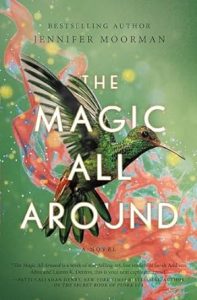Embracing Magic By Jennifer Moorman
Embracing Magic
By Jennifer Moorman
Magic has long been used in fictional stories, often as a plot device to move the characters from here to there, to solve problems that are otherwise unsolvable, and to explain why and how events unfold in a particular story.
Often magic is used in a way that’s not defined, meaning magic doesn’t have a limit and characters can do whatever the plot requires of them, no matter what. For example, a character approaches a locked door. No problem for someone who has a wand and knows the unlocking spell. What if a character needs to transform into someone else to sneak into the castle and save the day? Easy-peasy for a character who can transfigure at will into any human, creature, or object.
This kind of magic allows the characters to complete any task and overcome the obstacles they face. Part of the character’s journey might even be to find all the components of this crucial magic in order to complete the final task.
Another type of magic used in fiction requires a system. This type of magical world has rules that are clearly defined. Not only does the author know the rules, but so do the readers, and they know when magical rules are broken within the system. In this magical structure, characters are limited to their unique abilities. For example, if a wounded character needs healing, there might be only one magical person in the world who has this ability, and, therefore, the characters must go on a quest to find the great healer.
In many works of fiction, often both magical techniques are used. There is a combination of subtle and obvious magic in the story. Without rules, the limitless powers can often not be taken seriously or feel too “unrealistic.” There are rules but not so many that the readers are confused, or worse bored, by keeping track of an unwieldy system.
In The Magic All Around, I’ve incorporated a sprinkle of both types of magic. Mattie has an affect on music, whether the jukebox or the radio or even the records a DJ spins, and her magic helps her better understand herself and the events unfurling around her. Penelope can stitch love, comfort, and hope into clothing, and this helps support the people in town, even if they don’t understand the magic. Lilith has the uncanny ability to charm anyone and draw people toward her. While Jonathan has a way of bringing everyone together and raising morale. None of them share the same abilities, and there is a limit to how the magic works in their lives. Magic doesn’t solve their problems. Instead, it guides them toward the answers that have been with them all along. It opens doors for them (figuratively and literally) when they’re seeking truth.
The Magic All Around uses magic to unfold the story in a natural, organic way. Magic is also an integral part of the enchanted, whimsical tone of the story. Rather than magic being the main motivating element in their world, it’s just part of the way the characters see the world. It’s part of their daily lives—not something they broadcast to everyone, but rather a gift they must accept about themselves. Magic is a natural element, whispering through their lives, and eventually they all find ways to embrace it.
Regardless of how magic is used to drive the plot, it’s clear we love stories that captivate us with their charmed worlds and their everyday whimsy. Whether characters are falling down rabbit holes and attending tea parties or fighting the Telmarines alongside Prince Caspian, we are fascinated with magic and its ability to cast a spell over our imaginations.
—
https://www.jennifermoorman.com/
THE MAGIC IS ALL AROUND
 In this latest enchanting novel from bestselling magical realism author Jennifer Moorman, a treasure hunt through the past reveals one woman’s extraordinary gift for arranging the future.
In this latest enchanting novel from bestselling magical realism author Jennifer Moorman, a treasure hunt through the past reveals one woman’s extraordinary gift for arranging the future.
The Russell women have always lived in a house that is as special as they are—a century-old Victorian with a radio that tunes itself to the listener’s mood and a pantry that rearranges to provide just the right ingredients for any baking need. Lilith Russell was the exception. She left the family home in Ivy Ridge, Georgia, and has been flitting like a hummingbird from place to place with her daughter, Mattie, in the decades since, only returning each summer to drop Mattie off with Lilith’s sister, Penelope.
When Lilith dies suddenly, Mattie is left without her sole companion and the captain who steered her ship. That is, until she visits Ivy Ridge and learns Lilith charted one last course for Mattie: a series of tasks that she must complete to earn her inheritance, with Penelope overseeing the process.
Both Mattie and Penelope are outraged by Lilith’s seemingly random stipulations: throw a Halloween party, take a local pizza cooking class, share secrets with someone . . . But Mattie soon realizes that if she completes the tasks, she may unearth her mother’s secrets, including the identity of Mattie’s father. She may also discover more about the Russell family “gifts” and why Lilith chose Penelope’s former love to be the executor of the will. She may even learn how and why Jonathan Carlisle, the boy who stole her heart ten summers ago, also happens to be back in town.
Mattie can only hope that Lilith’s final map will finally point her home.
BUY HERE
Category: On Writing























